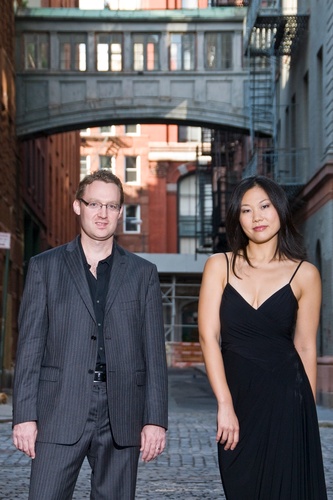Duo Stephanie and Saar show versatility in Dranoff Foundation program

Duo Stephanie and Saar performed a genre-crossing program Saturday night at the South Miami Dade Cultural Center.
The Dranoff Foundation enterprising concert programs have admirably highlighted rarely heard two-piano repertoire and Saturday night’s “Jazz Squared” concert at the South Miami Dade Cultural Center in Cutler Bay was no exception. Duo Stephanie and Saar traversed a menu of jazz-infused works with fine technique and musicality. Still, it’s clear that the husband-and-wife team of Stephanie Ho and Saar Ahuvia are classicists at heart and their strongest performances were in music of Chopin and Beethoven.
While architecturally imposing from the outside, the lobby of the South Dade center is rather cramped and the main auditorium lacks a sense of ambience, the decor mostly dark black. The sightlines, however, are good and the acoustics excellent. Piano sound was clear and immediate, the tone rounded and warm.
Aaron Copland’s original 1942 duo version of Danzon Cubano is less inspired by jazz than by the Latin dance hall rhythms and melodies he heard during a trip to Havana. Usually performed in his later orchestral version, the score’s layered voicings emerge with greater crispness and bite in the keyboard edition. The players nicely encompassed Copland’s melodic coloring but the percussive rhythms wanted greater drive and panache.
University of Miami professor Paul Posnak excels at arranging populist classics, and his transcriptions of four Gershwin songs were stylish and delightful. Someone to Watch Over Me superimposed Chopinesque flourishes on one keyboard over the melody in the other. A commingling of S’Wonderful and Funny Face fused echoes of Rhapsody in Blue with touches of ragtime and a blues-tinged It Ain’t Necessarily So culminated in a full-throttle stride finale.
Thomas Ades’ brilliant piano transcriptions of American iconoclast Conlon Nancarrow’s studies for player piano pose a formidable challenge to artists attempting the changing and differing meters superimposed over each other, sometimes four at a time. Studies in Ragtime Nos. 6 and 7 are deconstructions of dance tunes, and that Ho and Ahuvia actually played these originally mechanized pieces was nothing short of a remarkable feat. These almost impossible pieces were given strong, incisive advocacy.
The Dranoff organization regularly commissions new works. Saturday’s concert brought the premiere of Fantasia de Tres Mundos (Three Worlds Fantasia) by Miami-based jazz pianist and UM pedagogue Martin Bejerano. Bejerano’s score is a winner—authentic jazz, with funky Baroque alternating between hot riffs and cerebral breeziness. If Duo Stephanie and Saar seemed reticent in Posnak’s Gershwin vignettes, the duo hit a groove in Bejerano’s wonderful Afro-Cuban showpiece, even improvising with zest in segments that were not fully notated.
Best known for his playing and arrangements on the classic Miles Davis album “Kind of Blue,” Bill Evans was one of the great jazz pianists. Ahuvia’s transcription of the Evans standard A Time for Love suggested Rachmaninoff with blues for good measure.
Ukrainian composer Nikolai Kapustin’s Paraphrase on Dizzy Gillespie’s Manteca was replete with hard-driving energy but two pianos cannot replicate the unique sound of Gillespie’s trumpet.
Chopin’s infrequently heard Rondo in C Major channels typically aristocratic melodies with undertones of sadness. Playing with fizzing technique and élan, the duo fused bravura and elegance in perfect measure. Moving to one piano for their encore, a four hand version of the second movement Adagio ma non troppo from Beethoven’s String Quartet No. 6 in G Major captured the music’s serenity, the melodic interplay exquisitely realized.
Posted in Uncategorized
Leave a Comment
Sun Apr 20, 2014
at 1:55 pm
No Comments






